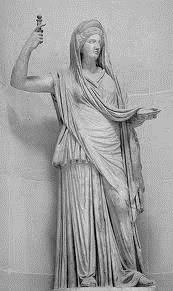

Libertas (Latin for “liberty” or “freedom”) is the Roman Goddess of Liberty—as well a personification Liberty. Libertas was given a temple on the Aventine Hill about 238 bce. In Rome, she became a politicised figure in the Late Republic, featured on coins supporting the “populares” faction. Nonetheless, Libertas sometimes appeared on coins from the imperial period, such as Galba's "Freedom of the People" coins, during his short reign after the death of Nero
The Roman Republic was established simultaneously with the creation of Libertas—and Libertas thus is associated with the overthrow of the Tarquin kings.
This Goddess is usually portrayed with two items: a spear upon which she holds out a phrygian cap on the spear. In Rome Libertas was often portrayed as a matron with a laurel wreath and/or a pileus (a conical felt cap given to freed slaves, hence the symbol of liberty). An image below this article apparently depicts a statue of Libertas holding a scroll of her head. (As statue of Libertas was indeed set up in the Forum, I wonder if this image below is the very same statue in the Forum?)
Libertas became a politicised figure in the Late Republic, featured on coins supporting the populares faction, and later those of the assassins of Julius Caesar.
In the USA Libertas appears as colossal “Statue of Liberty” upon Liberty Island in the Upper New York Bay, U.S.A.
This particular New York statue of Lady Liberty commemorated the friendship of the peoples of the USA and France.
Standing 305 feet (93 metres) high including its pedestal, it represents a woman holding a torch in her raised right hand and a tablet bearing the adoption date of the Declaration of Independence (July 4, 1776) in her left.
The torch, which measures 29 feet (8.8 metres) from the flame tip to the bottom of the handle, is accessible via a 42-foot (12.8-metre) service ladder inside the arm (this ascent was open to the public from 1886 to 1916). An elevator carries visitors to the observation deck in the pedestal, which may also be reached by stairway, and a spiral staircase leads to an observation platform in the figure’s crown. A plaque at the pedestal’s entrance is inscribed with a sonnet, “The New Colossus” (1883) by Emma Lazarus.
This sonnet was written to help raise money for the pedestal, and it reads:
Not like the brazen giant of Greek fame,USA Statue of Liberty
With conquering limbs astride from land to land;
Here at our sea-washed, sunset gates shall stand
A mighty woman with a torch, whose flameIs the imprisoned lightning, and her name
Mother of Exiles. From her beacon-hand
Glows world-wide welcome; her mild eyes command
The air-bridged harbor that twin cities frame.
“Keep, ancient lands, your storied pomp!” cries she
With silent lips. “Give me your tired, your poor,
Your huddled masses yearning to breathe free,
The wretched refuse of your teeming shore.
Send these, the homeless, tempest-tost to me,
I lift my lamp beside the golden door!”
Statue of Liberty, Upper New York Bay, U.S.
A French historian, Édouard de Laboulaye, made the proposal for the statue in 1865. Funds were contributed by the French people, and work began in France in 1875 under sculptor Frédéric-Auguste Bartholdi. The statue was constructed of copper sheets, hammered into shape by hand and assembled over a framework of four gigantic steel supports, designed by Eugène-Emmanuel Viollet-le-Duc and Alexandre-Gustave Eiffel. The colossus was presented to the American minister to France Levi Morton (later vice president) in a ceremony in Paris on July 4, 1884. In 1885 the completed statue, 151 feet 1 inch (46 metres) high and weighing 225 tons, was disassembled and shipped to New York City. The pedestal, designed by American architect Richard Morris Hunt and built within the walls of Fort Wood on Bedloe’s Island, was completed later. The statue, mounted on its pedestal, was dedicated by President Grover Cleveland on October 28, 1886. Over the years the torch underwent several modifications, including its conversion to electric power in 1916 and its redesign (with repoussé copper sheathed in gold leaf) in the mid-1980s, when the statue was repaired and restored by both American and French workers for a centennial celebration held in July 1986.
The New York site was added to UNESCO’s World Heritage List in 1984.
Sources:
Libertas